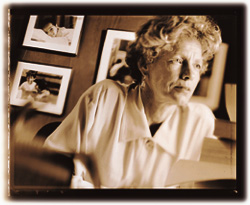Main Menu · Search · Current Issue · Contact · Archives · Centennial · Letters to the Editor · FAQs
 Do fertility medicines enhance the risk of cancer? "We don't know," says Selwyn Oskowitz, director of Boston IVF.
Do fertility medicines enhance the risk of cancer? "We don't know," says Selwyn Oskowitz, director of Boston IVF. |
Apart from the psychological ramifications, the new reproductive therapies involve hormonal and surgical interventions that may cause harm to mother and child. For many who are infertile, the risks of conventional drug therapy and ART may outweigh the potential benefits.
"I don't consider IVF to be a risk-free intervention," says Elizabeth Ginsburg, associate director of the IVF program at Brigham and Women's and an assistant professor of ob-gyn and reproductive biology. She had just performed an emergency procedure for an IVF patient who was hospitalized for severe hyperstimulation of the ovaries, the major potential complication of superovulatory drugs. It involves massive ovarian enlargement due to multiple cysts, among other things, and can cause death if untreated. The woman was not in danger, but "she was extremely uncomfortable and very distended," says Ginsburg. "This happens rarely, and this was our once-a-year."
Inducing ovulation through hormonal drugs has been around since 1938, so the possible side effects from such treatment are well known. In addition to the risk of hyperstimulation, multiple gestations occur in approximately 20 percent of ovulation-induced pregnancies (the formerly infertile couples who have triplets--or quints) and spontaneous abortions occur in 12 to 29 percent. Ectopic pregnancies, when a fertilized egg implants outside the uterus (usually in the fallopian tubes), occur in 3 to 5 percent of IVF pregnancies--or three times as often as they do in natural conceptions.

The long-term effects of infertility therapy are less clear, but some studies show an increased incidence of ovarian cancer. "Women who don't ever conceive are at higher risk for cancer of the ovary and for breast cancer," says Selwyn Oskowitz. "The question is whether fertility medicines enhance that risk or not, and we don't know." For Annie Geoghegan, the potential risk of ovarian cancer raises the specter of diethylstilbestrol (DES). The synthetic hormone, prescribed from the 1940s to the 1970s to prevent miscarriages, was eventually found to cause reproductive problems in the children of women who had used it. "Many of these infertile women are themselves DES daughters, but they're still willing to take the drugs," says Geoghegan. Alice Domar believes that "someone who's so driven to have a baby is willing to undergo anything--no matter what a consent form says."
Susan Pauker, assistant clinical professor of pediatrics and chief of the genetics department at Harvard Pilgrim Health Plan, is also worried about the effects on the children. "When we expose children to these manipulations without any knowledge of the long-range outcome, then we're vulnerable to the same experience as DES," she says. Pauker was a resident at Mass. General when the DES alert came out in the mid 1970s. "We said, 'Never again--like the Holocaust--will we stand by and watch while a drug is being utilized before we know the long-term outcome.'" She also points to a presumably benign element of ART--ultrasound, which electronically converts the echo of a sound wave into an image of the embryo or fetus. "What in the world leads us to think that aiming a high-frequency sound wave at rapidly dividing tissues is a safe thing to do?" she asks. In normal pregnancies, doctors use ultrasound once or twice, but in assisted reproduction, it is often required daily. "What do we do if they all have diminished hearing or diminished reproduction?" Pauker says. "The children absolutely are not giving informed consent." Nonethless, Oskowitz notes that, "remarkably, the studies thus far are finding very little in abnormalities, both genetically and adaptively."

For Mark Hornstein, "The foremost risk in my mind is the risk of high-order multiple gestation, which means triplets or more." In conventional infertility treatment, multiple gestation is due to superovulation. In ART, it is due to superovulation plus the practice of transferring several embryos at a time to the uterus in order to increase the chances for pregnancy. Because pregnancies of triplets or more endanger both mother and babies, doctors may perform a "multifetal pregnancy reduction." In this procedure, the most accessible gestational sac is injected with potassium. "Unfortunately," says Oskowitz, "a gestational pregnancy fetus has to be lost."
Great Britain and Australia restrict the number of embryos in a single transfer to three. The American Society for Reproductive Medicine (ASRM) condemns the practice of transferring excessive numbers of embryos with the intention of using multifetal reduction for mop-up, but stops short of an all-inclusive limit. Brigham and Women's has standard guidelines for how many embryos to transfer. A lot depends on a woman's age and how many IVF cycles she's been through, says Ginsburg, noting that "our upper cut-off" is five. Pauker recommends a different criterion: "I've always said that you should put in only as many eggs as you're willing to raise through college."
What happens to embryos that haven't been transferred? The not-so-good ones are discarded and the good ones are cryopreserved. Freezing has been the answer to quite a few prayers in assisted reproduction. It reduces the need to transfer a number of embryos at once, thereby reducing the need for fetal reduction. It also gives a woman another chance at getting pregnant without going through fertility drugs and egg retrieval, thereby reducing her risks. But embryo freezing raises its own dilemmas, medical and moral (see "Embryo Banking").
 Janet Taft and Renny Merritt have an "industrial strength family", including naturally conceived twins Breck and Riley, born in 1991, and their siblings, Sawyer and Whittaker, conceived through IVF with donated eggs and born in 1995.
Janet Taft and Renny Merritt have an "industrial strength family", including naturally conceived twins Breck and Riley, born in 1991, and their siblings, Sawyer and Whittaker, conceived through IVF with donated eggs and born in 1995. |
"We make babies from frozen eggs," Pauker says. "Who gives us the right to assume it is safe in the long run to utilize frozen fertilized eggs to make human beings?" As with many elements of ART, the long-term effects of cryopreservation are simply not known. In the interim, freezing allows many couples to take advantage of assisted reproduction without violating their beliefs. "We don't freeze every extra embryo after a transfer, because only embryos of good quality will survive freezing," says Elizabeth Ginsburg. "We check for things like division rate, fragmentation, the appearance of the cell membranes, and symmetry among cells." But for couples who are ethically opposed to discarding embryos, she says, "We'll freeze everything that's left over, even though we don't think that they're going to cause pregnancy in the future. I think you have to, because it's stressful enough without invading people's religious and moral beliefs."
Sara Bennett's decision to have her eggs retrieved makes it clear that the advances of reproductive science raise far more than technical and medical issues. Clinical geneticist Susan Pauker empathizes "deeply with people who want to have their own natural child." She also believes that ART "has gone beyond 'assisted' reproduction to manipulations that we certainly didn't dream of 20 years ago. We're getting away from the natural selective process of people being attracted to each other, one of whom had eggs, one of whom had sperm, and the male bearing the sperm to the site of ovulation. Our society is not prepared for the families that will result from these interventions."

When Judith Larkin was pregnant with her son Adam (both pseudonyms), she met with a genetic counselor who asked, "Who's the father?" When Larkin said, "I don't know," the woman stiffened. When she added, "He was an anonymous donor," the counselor let out a sigh of relief.
"My first choice was to be married and get pregnant in a nice, natural, normal way," Larkin says. But when she was 34 she wasn't married and she still wanted a child. She thought about it for a year before she decided, attending workshops held by Single Mothers by Choice. "For women who choose to become parents this way, it's a very conscious choice," she says. "Women I know agonize over it--How am I going to do this? Am I going to make a good mother? I think that's what makes good parents."
Larkin began artificial inseminations with donor sperm when she was 35, assisted by Clomid, the initial drug used to induce ovulation. After five unsuccessful cycles, she advanced to self-administered Pergonal injections. But after four cycles of that, all she had was a blocked tube caused by an earlier infertility procedure. If Larkin wanted to get pregnant, she had no choice but to move on to IVF.
Larkin found IVF to be an even more demanding experience than artificial inseminations with fertility drugs. As a freelance landscape architect, her schedule could accommodate the daily blood tests and ultrasounds. She was also injecting herself with Pergonal twice a day to produce even more eggs--which made her feel like she had "grapefruits for ovaries." Surgery retrieved nine eggs, about average for her age. When none fertilized, she was devastated. Her doctors concluded that there must be a sperm problem, so Larkin went back to the sperm bank to select her third donor. "You get attached to them," she says. "But you reach a point where you're ruthless about it. If he can't cut it, he's out of here."
 "There's an ethical dilemma with a procedure that systematically engages in embryo destruction," says law professor Elizabeth Bartholet.
"There's an ethical dilemma with a procedure that systematically engages in embryo destruction," says law professor Elizabeth Bartholet. |
To counter her increasing depression, Larkin relied on friends from Single Mothers by Choice who were going through ART as well. She also joined Alice Domar's mind/body program before her next try at IVF. "I felt like I could relax for the first time in a year," she recalls. This time her doctors retrieved 12 eggs, which were mixed with the new donor's sperm. Three of them fertilized, but only two survived until the transfer day. Larkin had to lie very still for hours; she thinks she "felt this little twinge" when an embryo implanted. Two weeks later, she was pregnant. "I called everybody I knew that day," she remembers. "It was thrilling. I loved being pregnant even though I was uncomfortable most of the time." She was 37 when her son was born.
Adam is now two and a half. "It's been really hard and really wonderful in all the normal ways," she says. But she admits she hasn't had a "typical single-parent experience." When she was consigned to bed rest during her pregnancy, an old friend she'd once been involved with was looking for a place to live. Jon (not his real name) moved in and took care of her. "He kind of fell in love with Adam and never left. We've gradually started functioning more and more like a family--though that wasn't anyone's intention." Adam had been calling Jon by name, but "just yesterday he said, 'You're my mommy and you're my daddy.'"
Larkin's own parents have been very supportive of her choice to be a single mother, but her three younger brothers aren't speaking to her. "They said this was a terrible thing to do, and I'd be a terrible mother, and they couldn't have a relationship with me if I was going to do it." Some ethicists are opposed to single women using IVF, as were fertility clinics themselves in the early years of ART. Brigham and Women's was the first Massachusetts program to treat single women, in the mid 1980s. Now, like Boston IVF, they welcome lesbian couples as well.
Most of the gay couples in the Brigham and Women's program use frozen sperm that's donated anonymously, but occasionally there are special requests, says Annie Geoghegan: "Two women want to use the sperm of one of their brothers, so that they're both genetically related to the child." As a social worker, she will help them sort through such questions as, "What's the relationship going to be? How do you tell the child?" Kenneth Ryan, M.D. '52, Ladd professor of obstetrics, gynecology, and reproductive biology emeritus, who is co-chair of ASRM's ethics committee, says his philosophy is, "If no one is exploited in the process, and the child is wanted and loved, there can't be anything wrong with it."

Some lesbian couples choose gestational surrogacy in order to have "a shared experience of a pregnancy," says Elizabeth Ginsburg. "One member of the couple's eggs are used, inseminated with donor sperm, and the other partner carries the pregnancy," she explains. Lesbians, like single women, have had to prove their infertility before participating in IVF. But a controversial protocol eliminating that requirement was recently approved, says Ginsburg, so that the "minority of lesbian couples who feel there's no other way that they can share a pregnancy" may be helped. Patients are screened to determine that the relationship is long-standing and monogamous, and they must have legal, adoption-like documents drawn up.
Ruth Hubbard, who has grandchildren by donor insemination, says her daughter's "partner is certainly as much a mother of those children as my daughter, whose biological children they are." But Hubbard thinks that exchanging eggs "is pretty darn silly. That's attaching a significance that's all in the head. If it's one person's egg, why shouldn't she have it? What have you done--scrambled eggs, but what else? A lot of intervention for nothing."
Some people may object to "using an elaborate medical technology to get around social convention, personal desire, and biological limitations," says Ryan, but the same questions apply to both heterosexual and gay couples: "What are the driving forces for this? Is the child being brought into the world wanted? How committed to each other are they?"
Main Menu ·
Search · Current Issue · Contact · Archives · Centennial · Letters to the Editor · FAQs
![]()